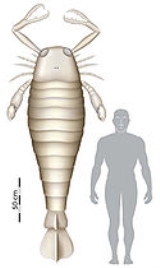
Jaekelopterus rhenaniae
Encyclopedia
Jaekelopterus rhenaniae ("Otto Jaekel
's wing from the Rhineland
") is an extinct species of the Eurypterida (sea scorpions). At an estimated length of 2.5 meters (8.2 feet), it is one of the two largest arthropod
s ever discovered (the other is a giant millipede
-like animal, Arthropleura
, although which animal was larger is unclear). The second largest eurypterid known is Pterygotus
. Jaekelopterus lived approximately 390 million years ago. Although called a "sea scorpion", it is speculated to have lived in fresh water rivers and lakes, rather than in saltwater seas. The animal was described by Simon Braddy and Markus Poschmann of the University of Bristol
in the journal Biology Letters
(November 2007); they found a 46 cm chelicera (claw-like mouth part), and estimated the total size of the animal based on the proportions of this claw. When extended, the chelicerae would have added another meter to its length.
The animal's fossilized remains were discovered in the Early Devonian (Emsian) Klerf Formation
Lagerstätte
of Willwerath near Prüm
, Germany
.
Otto Jaekel
Otto Max Johannes Jaekel was a German paleontologist and geologist.Jaekel was born in Neusalz , Prussian Silesia. He studied geology and paleontology in Liegnitz . After graduating in 1883, he moved to Breslau and studied under Ferdinand Roemer until 1885. Karl von Zittel awarded a PhD to Jaekel...
's wing from the Rhineland
Rhineland
Historically, the Rhinelands refers to a loosely-defined region embracing the land on either bank of the River Rhine in central Europe....
") is an extinct species of the Eurypterida (sea scorpions). At an estimated length of 2.5 meters (8.2 feet), it is one of the two largest arthropod
Arthropod
An arthropod is an invertebrate animal having an exoskeleton , a segmented body, and jointed appendages. Arthropods are members of the phylum Arthropoda , and include the insects, arachnids, crustaceans, and others...
s ever discovered (the other is a giant millipede
Millipede
Millipedes are arthropods that have two pairs of legs per segment . Each segment that has two pairs of legs is a result of two single segments fused together as one...
-like animal, Arthropleura
Arthropleura
Arthropleura was a 0.3–2.6 metre long relative of centipedes and millipedes, native to the Upper Carboniferous of what is now northeastern North America and Scotland...
, although which animal was larger is unclear). The second largest eurypterid known is Pterygotus
Pterygotus
Pterygotus is the second-largest known eurypterid, or sea scorpion and one of the largest arthropods of all time.-Description:...
. Jaekelopterus lived approximately 390 million years ago. Although called a "sea scorpion", it is speculated to have lived in fresh water rivers and lakes, rather than in saltwater seas. The animal was described by Simon Braddy and Markus Poschmann of the University of Bristol
University of Bristol
The University of Bristol is a public research university located in Bristol, United Kingdom. One of the so-called "red brick" universities, it received its Royal Charter in 1909, although its predecessor institution, University College, Bristol, had been in existence since 1876.The University is...
in the journal Biology Letters
Biology Letters
Biology Letters is a peer-reviewed scientific journal. It was split off as a separate journal from the Philosophical Transactions of the Royal Society B: Biological Sciences in 2005 after having been published as a supplement. Originally it was published quarterly, but from 2007 it has been...
(November 2007); they found a 46 cm chelicera (claw-like mouth part), and estimated the total size of the animal based on the proportions of this claw. When extended, the chelicerae would have added another meter to its length.
The animal's fossilized remains were discovered in the Early Devonian (Emsian) Klerf Formation
Klerf Formation
The Klerf Formation is an Early Devonian formation that includes a Lagerstätte in the Northern Eifel hills, at Willwerath near Prüm, Rhineland-Palatinate, Germany. In it Jaekelopterus rhenaniae, a giant eurypterid was discovered. The Klerf Formation was first described in 1919 by Rudolf Richter ....
Lagerstätte
Lagerstätte
A Lagerstätte is a sedimentary deposit that exhibits extraordinary fossil richness or completeness.Palaeontologists distinguish two kinds....
of Willwerath near Prüm
Prüm
Prüm is a town in the Westeifel , Germany. Formerly a district capital, today it is the administrative seat of the Verbandsgemeinde Prüm.-Geography:...
, Germany
Germany
Germany , officially the Federal Republic of Germany , is a federal parliamentary republic in Europe. The country consists of 16 states while the capital and largest city is Berlin. Germany covers an area of 357,021 km2 and has a largely temperate seasonal climate...
.

